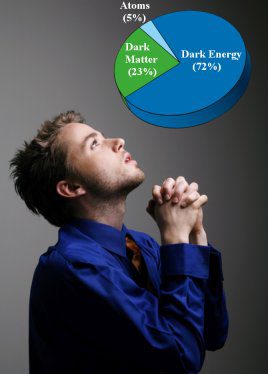[Originally published as Many Scientists Believe Scientific Theories Religiously]

Those who use the Big Bang as their model for understanding the formation of our universe are forced to believe that the vast majority of the universe is made up of material about which scientists know absolutely nothing.
As shown in the picture, to believe in the Big Bang model today, you must believe that all the matter involved in all the experiments done by all the scientists in history makes up only about 5% of the universe.
72% of the universe is composed of dark energy, a form of energy that was completely unknown until the 1990s and is so far undetectable and not understood at all.
The other 23% is made of dark matter, which is matter that we cannot see because of the limitations of our experimental capabilities.
Scientists have been trying to detect dark matter for decades, but so far, nothing has been found.
Why must those who are guided by the Big Bang believe that the vast majority of the universe has gone undetected?
The Big Bang model predicted that, over time, the expansion of the universe should be slowing down since all matter is gravitationally attracting all other matter. However, data that started being collected in the 1990s indicate that in the past, the expansion of the universe was slower, which implies that the universe’s expansion is actually speeding up. The current amount of dark energy that is supposed to exist is what’s necessary to retrofit the Big Bang model to allow for this increase in the expansion rate.
Belief in dark matter, on the other hand, is used to explain around certain observations that are surprising based on currently-accepted physics.
For example, the way most galaxies rotate is not what is expected based on Newton’s Universal Theory of Gravitation, but assuming a specific distribution of unseen matter, we can “fix” the galaxies, so they rotate as expected. In addition, there are ways to indirectly determine the mass of galaxies, and those indirectly-determined masses usually don’t agree with the masses indicated by the matter that we can see in them. Thus, there must be unseen matter there.
On a personal level, I think dark energy exists only in the minds of those who are committed to the Big Bang Model. I see no serious evidence for its existence.
Dark matter, on the other hand, has at least some serious evidence behind it. After all, either the physics as we currently understand it is wrong, dark matter really exists, or something else that hasn’t been theorized exists to explain the discrepancies.
Of course, as anyone who has read this blog for a while knows, I am just as likely to believe that the physics we currently “know” is wrong. As a result, I have always been intrigued by an alternate model of gravity called Modified Newtonian Dynamics (MOND). Its proponents claim that it can not only account for all the effects currently attributed to dark matter but it has also made predictions that have later been confirmed by new data.
Well, one of its proponents recently wrote an article for The Institute for Art and Ideas. The title is simple and says it all: “Dark Matter Doesn’t Exist.” He goes through experimental evidences that support MOND, and he notes the failures of multiple searches for dark matter. While I am inclined to think that MOND is more likely to be true than dark matter, I am not convinced that it is the way to go.
However, I did find this statement in his article very interesting:
We need to scientifically understand why the dark-matter based model, being the most falsified physical theory in the history of humankind, continues to be religiously believed to be true by the vast majority of the modern, highly-educated scientists. This is a problem for the sociological and philosophical sciences and suggests a breakdown of the scientific method.
While I am not sure that the dark matter hypothesis is “the most falsified physical theory in the history of humankind,” I wholeheartedly agree with him on the rest of his point.
I would also broaden his statement to include many other scientific theories, like evolution as a creation myth, the dogmatic belief that the earth is billions of years old, and the Big Bang model. One of the problems that exist in science today is that too many scientists believe these theories with a religious fervor. As a result, they tend to reject all the evidence that questions them. This, of course, holds back science.
While I don’t know if MOND is the correct answer to the question of why certain astrophysical observations are not consistent with currently-accepted physics, I can say that this particular MOND proponent has hit the nail on the head when it comes to a very big problem in today’s scientific enterprise!







